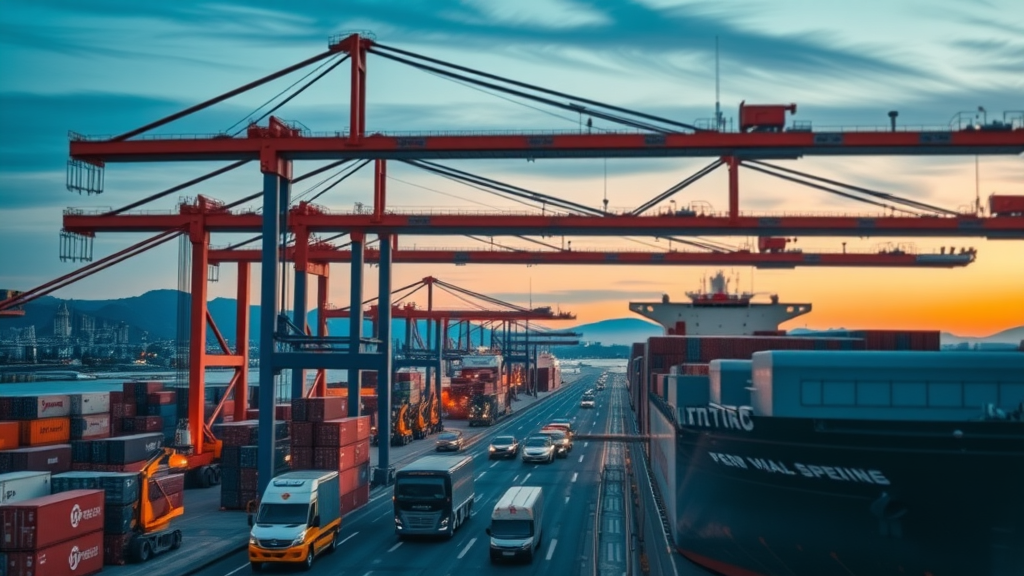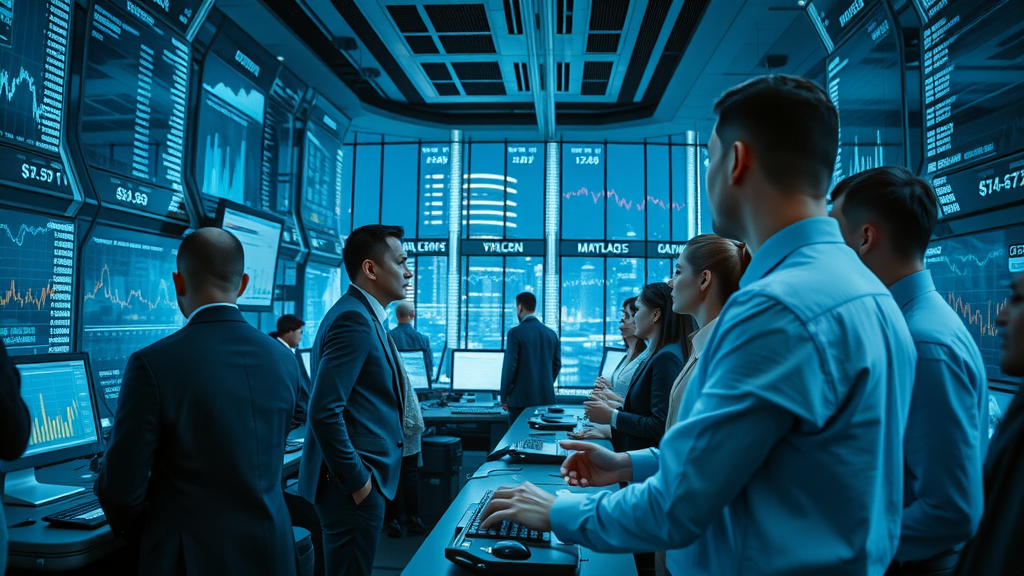Did you know that global trade volume soared past $32 trillion in 2023? This incredible figure underscores the vast influence that international commerce wields over every country, business, and individual. As markets evolve at lightning speed and new forces disrupt the status quo, it’s never been more crucial to understand how a global trade review sheds light on today’s market shifts and paves the way for actionable strategies. Read on to discover why industry leaders and investors rely on comprehensive trade reviews to shape their next move—and how you can use these insights to fuel growth and manage risk.
Revealing Market Shifts: The Importance of a Global Trade Review
“In 2023, global trade volume surpassed $32 trillion, underscoring its undeniable influence on every economy.” – United Nations Conference on Trade and Development
A global trade review has emerged as an indispensable tool for companies and individuals involved in global commerce. As international trade continues to expand and shift, it’s vital that organizations keep their finger on the pulse of recent economic developments. Recent statistics reveal patterns that might otherwise go unnoticed; for example, the surge in digital trade echoing advancements in technology, or the subtle but significant effects of regional agreements on commodity and supply chain networks. These shifts have a direct impact on supply chain resilience, commodity pricing, and the design of new products and services for companies.
- How recent trade statistics reflect ongoing global shifts
- An exploration of unexpected forces driving change
- Why global trade reviews are more critical now than ever

Examining Global Trade: Key Trends and Data Shaping Current Markets
In the post-pandemic global economy, trends in international trade are increasingly complex and dynamic. Supply chain disruptions, evolving consumer demands, and advancements in digital trade platforms are reshaping the foundations of global commerce. For example, countries once dependent on a narrow set of trading partners are broadening their networks to mitigate political risk and sudden regulatory changes. These trends aren’t just academic; they directly affect the working capital exposure and profitability of companies and individuals involved in global markets.
| Year | Global Trade Volume (USD) | Top Exporters | Top Importers |
|---|---|---|---|
| 2020 | $28 trillion | China, US, Germany | US, China, Germany |
| 2021 | $30 trillion | China, US, Netherlands | US, China, UK |
| 2022 | $31 trillion | China, US, Germany | US, China, Japan |
“A deep-dive global trade review helps reveal not only where markets are heading, but also the underlying risks and opportunities.”
Trade Review Methodologies: What Data Sources Matter Most?
Conducting a trade review today requires leveraging a diverse array of data sources for a comprehensive perspective. International organizations such as the World Trade Organization (WTO) , IMF , and the World Bank supply foundational trade statistics. Additionally, national export and import registries provide accurate, country-level insights that help pinpoint emerging patterns in global trade review . Increasingly, trade finance institutions and fintech service providers are supplementing these benchmarks with real-time transaction data, revealing trends in trade fi and working capital cycles. For service providers and companies, staying current with this data is key to managing supply chain risk and capitalizing on new market opportunities.
- International trade organizations (WTO, IMF, World Bank)
- Country-specific export/import registries
- Trade finance institutions
Global Trade Review: The Shifting Dynamics of International Trade
The global trade review continues to highlight significant transformations in the international trading landscape. The rise of regional agreements, such as the RCEP or CPTPP, is shifting global trade flows and altering the role of traditional powerhouses. Tariffs and protectionist measures are making cross-border trade more challenging, while digital trade is redefining how goods and services are exchanged. These evolving dynamics force both large companies and mid-sized service providers to rethink their supply chain and market strategies.
Major Shifts in International Trade Flows
- Rise of regional trade agreements
- Impact of tariffs and protectionism
- Evolving role of digital trade
The trade review reveals that regionalism is not just about geography; it is about shared interests, standards, and digital interconnectivity. Protectionist policies, on the other hand, force companies to continually adapt their supply chains, evaluate chain finance solutions, and balance risk and trade credit exposure. Meanwhile, digital trade—now an engine of growth—allows businesses to reach new consumers and streamline logistics, further underscoring the importance of keeping up with trade fi innovations.

Supply Chain Transformations: From Disruption to Resilience
- Pandemic-driven changes
- Reshoring and near-shoring strategies
- Sustainability as a new supply chain imperative
In the wake of global disruptions such as the COVID-19 pandemic, businesses undertook major overhauls to their supply chain models. Many adopted reshoring and near-shoring to reduce exposure to distant political risk and shorten lead times. Sustainability is no longer optional; companies that integrate ESG (environmental, social, governance) standards into their commodity and supply chain finance cycles gain a clear competitive edge. This phase of transformation highlights the importance of conducting regular global trade reviews to maintain resilience, ensure compliance, and leverage upcoming trends in both finance markets and logistics.
Trade Finance and Trade Review: Financial Engines of Global Commerce
Trade finance, often spotlighted in any comprehensive global trade review , provides the essential fuel for international trade. Working capital solutions, trade fi innovations, and credit instruments all enable businesses to thrive, even in volatile environments. The expansion of digital platforms in finance markets means that more companies and individuals involved in global trade can access new working capital services and manage risks more efficiently. As financial instruments evolve, understanding their impact through recurring trade reviews becomes ever more vital for service providers.
How Trade Finance Drives Global Trade
- Letter of credit and risk mitigation
- Working capital optimization
- The growth of digital trade fi (finance) platforms
By providing solutions such as letters of credit, trade finance institutions help to minimize credit risk and facilitate secure transactions between international partners. Working capital optimization allows companies and individuals involved in global trade to unlock resources tied up in supply chain operations and invest in growth opportunities. The rise of fintech providers and blockchain-based platforms accelerates the speed, transparency, and security of cross-border trade, making trade fi an integral part of modern commerce.
Challenges and Innovations in Trade Finance
- Regulatory hurdles
- ESG (environmental, social, governance) standards
- Blockchain and fintech solutions
As regulations grow more complex and ESG expectations increase, businesses must adapt their financial operations to remain compliant. Blockchain and fintech providers are tackling traditional inefficiencies, offering quicker settlement times, enhanced traceability, and reduced costs. For companies and service providers, being proactive in trade review methodologies helps anticipate new regulatory shifts and leverage technology-driven innovation for greater profitability and sustainability.

Current Barriers and Opportunities from a Global Trade Review
- Geopolitical disputes and trade wars
- Inflation and monetary policy shifts
- Emerging market growth and new opportunities
Geopolitical volatility—from trade wars to sudden sanctions—remains a persistent challenge in global trade review . Inflation and shifting monetary policies add pressure to working capital and trade credit management for organizations of every size. Yet, these obstacles are matched by significant potential: fast-growing emerging markets, technological advances, and greater access to chain finance solutions provide new avenues for companies and service providers to expand. By reviewing recent data and aligning strategies accordingly, organizations can turn volatility into opportunity.
Expert Voices: Quoting Industry Leaders on the Future of Global Trade
“As global trade review becomes more data-driven, companies must embrace analytics to stay ahead.” – Trade Economist, Global Insights Group
“Supply chain resilience will define competitive advantages in the next decade.” – International Trade Consultant

Lists & Comparisons: What Makes a Global Trade Review Essential
- Pinpoints market entry and exit timing
- Highlights at-risk supply chains
- Identifies shifting consumer demands
- Assesses working capital exposure
The value of a rigorous global trade review extends far beyond compliance. It helps editorial teams, business leaders in trade, and financial analysts spot both immediate risks and strategic opportunities. With timely reviews, companies can fine-tune their market strategies, minimize losses from supply chain disruptions, and maximize their exposure to high-growth regions or segments. Whether for a multinational or a fast-scaling startup, ongoing trade reviews are the key to unlocking effective, data-driven decisions and gaining a competitive edge in the global marketplace.
What You'll Learn from This Global Trade Review Perspective
- How recent market movements are reshaping global trade
- Why supply chain changes are upending industry predictability
- Which financial innovations are transforming trade review
- Where global opportunities and risks are emerging for investors and businesses

Is Global Trade Good or Bad?
Evaluating the Positive and Negative Impacts of Global Trade
- Positive: Economic growth, access to new markets, consumer choice
- Negative: Job displacement, environmental strains, inequality
The impact of global trade is complex and multi-layered. On one hand, it drives economic growth, unlocks new markets, and expands consumer choice. On the other, it has led to job displacements in vulnerable industries, environmental stress due to increased logistics, and widened inequality in both developed and emerging economies. A balanced trade review must therefore weigh the net societal benefits against these real, persistent challenges—and encourage policies that maximize value while minimizing harm.
Opinion Analysis: Striking a Balance in Global Trade Review
Achieving a fair balance in global trade requires integrating sustainability, inclusivity, and adaptability into every facet of international commerce. Policymakers, business executives, and individuals involved in global operations must support transparent trade review processes. This allows for the identification of risks such as concentrated supply chain exposure or trade credit fragility, while also spotlighting opportunities for innovation and shared prosperity. Ultimately, a thoughtful, ongoing global trade review empowers both private companies and public institutions to steer trade in a direction that benefits the greatest number.
How Does Global Trade Work?
Processes, Players, and Technology in Global Trade Review
- Negotiation of trade agreements
- Cross-border payment systems
- Supply chain logistics and regulations
At its core, global trade is the movement of goods, services, and capital across borders. Key players include exporters, importers, logistics providers, and financial service providers. The process begins with the negotiation of trade agreements, followed by the orchestration of complex logistics and compliance with a patchwork of regulations. Cross-border payment systems are now increasingly digital, streamlining transaction speed and lowering costs. Each of these steps is scrutinized in a robust trade review , ensuring all involved parties—from manufacturing giants to companies and individuals involved in niche commodities markets—operate efficiently and lawfully.
How Much Money Is in Global Trade?
Quantifying the Scale in This Year’s Global Trade Review
Global trade remains among the largest financial engines in human history, with volumes consistently exceeding $30 trillion in recent years. According to the latest global trade review , this immense scale covers not only physical goods and commodities but also digital products and services. Each year, trillions of dollars flow between continents, influencing job creation, government revenues, and the global economic balance. This monumental market size highlights why even small shifts in policy, supply chain logistics, or working capital cycles can trigger far-reaching impacts.
What Is Global Trade Finance in the Context of Trade Review?
Exploring Core Concepts, Instruments, and Risks
- Role of financing in international trade
- Key products: letters of credit, documentary collections, trade credit insurance
- Risks: currency fluctuation, credit risk, geopolitical events
Global trade finance refers to a range of financial instruments and services that facilitate international commerce. Letters of credit, documentary collections, and trade credit insurance all play a role in bridging confidence gaps between unfamiliar trading partners. Effective trade fi management helps buffer companies from risks like currency fluctuations or sudden geopolitical events. Regular trade reviews by editorial teams and financial experts ensure that organizations can adjust their strategies to safeguard working capital and seize open opportunities in fast-changing finance markets.
Video: How Global Trade Review Shapes Policy and Markets
(Video Placeholder—Imagine an insightful panel featuring leaders in trade, discussing how rigorous global trade reviews inform government policy, supply chain standards, and international trade agreements. Main keyword: global trade review.)
Video: Experts Discuss the Future of Global Trade Review
(Video Placeholder—This engaging roundtable would spotlight GTR leaders and editorial team members analyzing trade fi trends, digital platforms, and emerging service providers. Keyword focus: trade review, supply chain, finance markets.)
FAQs on Global Trade Review
- How often should companies conduct a global trade review? Companies involved in global trade should conduct a comprehensive trade review at least annually, with interim updates triggered by major policy changes or supply chain disruptions. This frequency ensures that working capital, risk management, and supply chain finance strategies remain responsive to evolving market conditions.
- What are the key risks highlighted in a comprehensive trade review? A robust trade review reveals multiple risks—including geopolitical instability, regulatory changes, supply chain disruptions, and currency fluctuations. Identifying these early enables businesses to safeguard trade credit and adjust their chain finance strategies accordingly, maintaining operational stability and growth.
- How is global trade review evolving with new digital platforms? New digital trade platforms are transforming the review process by providing real-time analytics, transparent data, and faster access to trade finance markets. This evolution makes it easier for companies and editorial teams alike to monitor risk, track working capital needs, and make more informed decisions about international trade strategies.
Looking Forward: Navigating Uncertainty through Consistent Global Trade Review
In today’s volatile market, continuous global trade review is the key to resilience and long-term growth. Make it a strategic priority—invest in data-driven reviews and agile responses to stay ahead.
Interested in contributing thought leadership or authoring future reviews? Reach out to Global Trade News at 203 271 7991 for more information and collaboration opportunities.
To deepen your understanding of current global trade dynamics, consider exploring the following resources:
-
The article “World Bank cuts global growth forecast as trade tensions heighten uncertainty” provides insights into how escalating trade tensions and rising tariffs are impacting global economic growth, with projections indicating a slowdown to 2.3% in 2025. ( reuters.com )
-
In “Trade war resolution may require concessions from all, ECB’s Lagarde says,” European Central Bank President Christine Lagarde emphasizes the necessity for mutual concessions to resolve ongoing global trade disputes, highlighting the adverse effects of protectionist policies on global prosperity. ( reuters.com )
These articles offer valuable perspectives on the challenges and considerations shaping international trade today.
 Add Row
Add Row  Add
Add 




 Add Row
Add Row  Add
Add 

Write A Comment